Last Updated on February 19, 2024
Table Of Contents
- 29 Interesting Facts About The Paris Catacombs
- Waking The Dead
- Celebrities From French History Are Buried In The Catacombs
- Moved In The Darkness Of The Night
- The Paris Catacombs Were Originally Used As Quarries
- Artistic Depictions Of Bones
- Over 6 Million Parisian Remains
- People Get Lost In The Catacombs
- The Catacombs Attract Famous People Too
- The Mysterious Footage
- The Unspoken Horrors
- The Catacombs Were Used During World War II
- The Catacombs Extend From A “Gate Of Hell”
- An Underground Oenological Heist
- Catacomb Parties
- Paris Catacombs Legend
- A Gruesome Murder
- Mushroom Farm
- You Cannot Touch The Bones
- The Catacombs In Paris Were Built Following Rome’s Version
- Paris Catacombs Are Not The Oldest in the world
- You Can Go Swimming
- Certain Sections Are Accessible To The Public, While Others Are Restricted From Entry
- Some Sections Of The Catacombs Remain Uncharted And Unexplored
- Thousands Visit Every Year
- The Black Line On The Ceiling Means Something
- Low Ceilings
- It Is Very Quiet
- The Final Bones And Remains Were Placed In The Catacombs In 1860
- Construction Of Tall Buildings Near The Catacombs Is Prohibited
- Quick Paris Tips
- Paris Catacombs FAQ
- Know Before You Go
Catacombs Of Paris
Today, Paris boasts iconic landmarks and galleries that captivate visitors from around the globe. Exploring the city of lights is like stepping into a dream. However, Paris wasn’t always this enchanting. It has a haunting past, even amidst its reputation as the city of romance. The Paris Catacombs, otherwise known as “The Empire of Death,” represents a unique blend of “dark tourism” and “mass tourism”, where history takes on a mysterious allure.
From the city streets, it is hard to imagine the endless system of labyrinth tunnels and passageways that lie beneath your feet. Paris has more than 200 miles of quarry tunnels in a huge maze, with nearly all of them off-limits. One part of the tunnels you can legally visit houses the Catacombs of Paris.
The Catacombs have sparked the curiosity of countless individuals throughout history. Notable figures like Napoleon III were early visitors, and this underground labyrinth has also been immortalized in literary works like “Les Miserables”. Even in more recent times, the tunnels played a significant role. During the occupation of France by Nazi Germany in World War II, sections of the tunnel system were utilized by the French Resistance.
29 Interesting Facts About The Paris Catacombs
Waking The Dead
Paris in the 17th century thrived as a vibrant metropolis, surpassing all other European cities in size. It was an era of remarkable innovation, boundless growth, and limitless imagination. However, due to the city’s age, its cemeteries were plagued by overcrowding, resulting in the unsettling reality of frequently disturbed graves.
Some residents living in specific neighborhoods, such as those in close proximity to Les Innocents, the city’s oldest cemetery, expressed grievances about the overpowering stench emanating from decomposing bodies. In 1786, the mayor of Paris was forced to do something about it.
This led to significant health issues among the living population, necessitating the relocation of bodies from the cemeteries in the end. As a result, 6 million bodies were excavated and subsequently transferred to the catacombs of Paris, which are now housed in the former quarry tunnels. In total, 17 cemeteries, 160 places of worship and 145 monasteries and convents were added to the Catacombs.
Celebrities From French History Are Buried In The Catacombs
Within the catacombs, amongst countless anonymous individuals, lie the resting places of notable figures from French history. Among them are Nicolas Fouquet, Louis XIV’s esteemed superintendent of finance, as well as Colbert, Rabelais, Jules Hardouin-Mansart, Racine, Blaise Pascal, Maral, Lully, Danton, Robespierre, and Lavoisier. It is worth noting that the catacombs also hold the remains of the 1343 individuals who met their end at the guillotine during the Reign of Terror at the Place de la Concorde. Despite their historical significance, the identities of these “illustrious” individuals can never be definitively determined, as their remains intermingle with countless others.
Moved In The Darkness Of The Night
The task of relocating the bones to the catacombs was a major undertaking. It took nearly 12 years for over 200 gravediggers to complete this macabre mission, and it’s said that they worked mostly under the cover of night to mitigate the Church and Parisians’ reactions.
The gravediggers would carefully collect and transport a skull or bone in each basket, while torches and lanterns lit the way. As they moved through the darkness, a strange processional chant echoed through the tunnels:
“Bring out your dead,” they repeated. It was this eerie soundtrack that created the lasting impact of the Catacombs as one of Paris’s most mysterious attractions.
The Paris Catacombs Were Originally Used As Quarries
Former limestone quarries repurposed in the late 1700s as an ossuary- or storage facility for human remains- and remain a popular tourist destination today that still manage to impress visitors with their vast history and unique atmosphere.
Artistic Depictions Of Bones
When the bones were transported to the Catacombs, they were unceremoniously dumped in disorganized piles. Louis-Étienne Héricart de Thury was responsible for overseeing the conversion of the quarries into the haunting and artistic space that remains in the Catacombs to this day.
The walls of the catacombs are not simply lined with bones. As you meander through the tunnels, you can also find creative works of art that depict themes such as death and mortality. Skulls and femur bones are arranged into unique shapes to create an atmosphere of reverence for those who have passed away.
One particular display, called ‘The Monuments of Fortitude’, has a particularly powerful impact. It’s composed of rows of skulls and is meant to represent how the human spirit can remain strong even during life’s darkest times.
Over 6 Million Parisian Remains
The catacombs contain the remains of over 6 million Parisians, with skulls and other bones lining the walls, that have been preserved for centuries, making it one of the most incredible and spooky attractions in the world.
Today, it stands as a reminder of Paris’ past and the ultimate mortality of us all.
The Catacombs of Paris stand as a reminder that even in death, we can remain buried together for eternity.
People Get Lost In The Catacombs
The Catacombs were once fully open to the public, however, due to the sheer size and complexity of this unique landmark, it can be easy for visitors to lose their way, especially if you go into areas that are out of bounds today.
During the French Revolution, a doorman named Philibert Aspairt supposedly took a wrong turn and found himself in the tunnels of the catacombs while passing through a hospital’s courtyard. Astonishingly, it took 11 long years for his remains to be discovered by a group of cataphiles, tragically close to an exit.
The Catacombs Attract Famous People Too
The Paris Catacombs are a unique and fascinating destination that has attracted many famous visitors throughout history. Napoleon III, Victor Hugo, Charles Baudelaire, and even Jim Morrison have each explored the depths of the underground city at one time or another.
The Mysterious Footage
Some adventurous trespassers made a bone-chilling discovery. Deep within, they unearthed a video depicting a man desperately fleeing from an enigmatic presence. The authenticity of this footage continues to spark debate among experts, leaving countless minds to ponder the unfathomable horrors that may lie concealed within the catacombs.
The Unspoken Horrors
Beneath the veil of known secrets lies an abyss of unspoken horrors, patiently awaiting discovery within the catacombs. The immense expanse and intricate complexity of this subterranean labyrinth guarantee an abundance of chilling surprises yet to be unveiled. Each step ventured into the Catacombs holds the potential of encountering something that will send an icy shiver down one’s spine.
The Catacombs Were Used During World War II
The Catacombs of Paris also played a role during the Second World War. In 1940, Nazi Germany occupied France and soon after began its persecution of French Jews. During this time, the Catacombs served as a safe haven for persecuted citizens who sought refuge in its deep tunnels, offering them protection from German forces.
In addition, members of the French Resistance also used the Catacombs to hide from Nazi soldiers, as well as to store weapons and ammunition. The Catacombs provided a unique sanctuary during one of history’s darkest periods, offering a beacon of hope in the face of insurmountable odds.
The fact that this underground labyrinth has withstood centuries of turmoil is a testament to its endurance and resilience. Even after all these years, the Catacombs remain a popular attraction in Paris and a reminder of its tumultuous past.
The Catacombs Extend From A “Gate Of Hell”
Just outside the city, two tollhouses were once known as the Barrière d’Enfer, or the Gate of Hell. The catacombs extend south from these Gates. This makes the Catacombs being referred to as “The Empire of Death” extremely fitting.
An Underground Oenological Heist
Burglars Penetrated the Paris Catacombs and Pilfered $300,000 Worth of Wine
The burglars cunningly stole a collection of exquisite wine from the cellar of an upscale apartment building near the picturesque Jardin du Luxembourg. Investigators speculate that they surreptitiously penetrated the limestone wall of the Catacombs, making off with approximately $300,000 worth of precious grand cru bottles. In a statement to the French media, a police spokesperson asserted that the perpetrators were not mere opportunists; they had clearly scoped out the cellar beforehand. “The suspects deliberately targeted that specific wall,” they revealed.
The Mines have an extensive network that is closed at night and only a portion is accessible to the public during the day, with some portions requiring a guide. The queues for this eerie attraction stretch around the block, but for the resourceful, there are alternative entrances. Hidden throughout the city are secret openings, often former sewer access points.
Catacomb Parties
Certain secret entrances to the Catacombs clandestinely guide people to underground parties and concerts, which exist in a legal gray area. In one remarkable instance, the police stumbled upon a chamber transformed into a fully equipped movie theater, complete with a screen, projector, and even a restaurant. The thrill of watching a chilling film in the tunnels on Halloween is an experience beyond compare.
Paris Catacombs Legend
According to a famous legend surrounding the Paris Catacombs, something terrifying unfolds within the burial site after midnight. If you happen to find yourself inside the catacombs during those hours, it is advised to remain vigilant. As the tale goes, the walls themselves come alive, their dormant voices attempting to lure you deeper into the catacombs until escape becomes impossible.
A Gruesome Murder
According to the tale, there once lived a man by the name of Alexandre Francornard. He possessed an uncultivated demeanor, yet was deemed “exceedingly handsome”. In the vibrant city of Paris, he found himself captivated by the affections of a prosperous widow. This widow, who had been mourning her departed spouse for two years, had a three-year-old with her deceased husband. She decided to pay a visit to Francornard where he served as a guide for those who wished to explore the catacombs, which, until the year 1830, were open for unrestricted wanderings. However, on that fateful night, neither the widow nor her daughter resurfaced from the depths below. As dawn broke the next day, Francornard made a hasty escape from the confines of Paris. We’ll spare you the disturbing details of the discovery.
Mushroom Farm
The Catacombs have served various purposes throughout history, but perhaps one of the most peculiar is their utilization for mushroom cultivation.
During the 1800s, farmers undertook the cultivation of mushrooms within the abandoned quarries beneath the French capital. In the depths of these Catacombs, in their dark and cavernous chambers, farmers once nurtured a particular variety of button mushrooms. This unique fungus proudly bears the name of the illustrious French capital – the Paris mushroom.
There are numerous anecdotes surrounding how farmers stumbled upon the use of underground tunnels for cultivating mushrooms. One such tale suggests that deserters from the Napoleonic army sought refuge in these tunnels and discovered the ideal conditions for mushroom growth.
Word of this discovery quickly spread, prompting other farmers to eagerly allocate space for their mushroom cultivation. This practice endures to this day, though to a much smaller extent, yielding mushrooms of exceptional flavor.
You Cannot Touch The Bones
The Catacombs can be a rather eerie place. While many visitors come to explore the remnants of Paris’s past, it is important to remember that these catacombs are still an active burial site and should be respected as such.
In some sections, there are signs posted reminding tourists not to touch or take any artifacts from the Catacombs. While this is widely agreed upon, some have disregarded the warnings and attempted to take bones for their personal collections. In addition to being illegal, there are other dangers associated with such activities: those who disturb the dead can expect a visit from La Maîtresse des Catacombes – a mysterious figure who has been known to haunt anyone foolish enough to tamper with the remains.
You can also not eat or drink inside the Catacombs; doing so can be deemed a disrespectful act. It is best to respect this sacred burial ground and take only pictures of your visit.
The Catacombs In Paris Were Built Following Rome’s Version
The Catacombs of Paris were designed after the ancient Roman Catacombs. These subterranean tunnels served as a place to bury their dead, with bodies laid to rest in chambers carved into the soft limestone beneath the city. During that era, Rome took measures to prevent the spread of the plague, leading to the implementation of intricate underground burial systems. Later, under the rule of the Napoleon Empire, it was decided to arrange the bones in a necropolis, inspired by the Roman Catacombs.
Paris Catacombs Are Not The Oldest in the world
As mentioned above, the Paris Catacombs were built following Rome’s version, but there are even older catacombs than that!
Although the Paris Catacombs have a long and rich history, they are not the oldest catacombs in the world. The oldest known burial site is located in Alexandria, Egypt and dates back to 12th Century BC. Other ancient burial sites include those found in Mycenaean Greece, which date back to 1500 BC; and some constructed by Etruscans in Italy, which date back to 600 BC. Despite not being the oldest catacombs in existence, the Paris Catacombs remain one of the most visited and well-known burial sites in the world.
You Can Go Swimming
A courageous diver has turned the century-old, frequently flooded tunnels into his aquatic playground. He has fearlessly ventured into countless meters of uncharted galleries. Thanks to his meticulous mapping, the Department of Quarries inspection has finally become aware of the existence of many of these hidden tunnels.
Please be aware that this is not at all a leisurely pursuit suitable for novices. Navigating through narrow, pitch-black tunnels while wading through murky waters up to your waist is an experience that can catch you off guard, even with the allure of pristine, azure waters awaiting you at the tunnel’s end.
Furthermore, it goes without saying, that all of this is highly unlawful.
Certain Sections Are Accessible To The Public, While Others Are Restricted From Entry
As you navigate through the dark tunnels, pay close attention to any signs indicating that a certain entrance is off-limits. There are 1.5km of walking paths open to the public that are well-maintained. There are nearly two hundred miles of un-groomed and off-limits tunnel systems within the maze. Local daredevils, yearning for adventure, have ventured into these forbidden tunnels. The locals who explore these closed-off trails are called Cataphiles, and they rarely reveal their secret areas and entrances.
A €60 fine is imposed on cataphiles or rogue tourists discovered lurking in the illegal sections of the catacombs, which are under regular patrol by E.R.I.C, a specialized police force.
Some Sections Of The Catacombs Remain Uncharted And Unexplored
The exact size of the underground network is unknown and continues to baffle experts. Over time, additional sections have been unearthed by archaeologists and urban explorers alike.
There was no record of the distance covered or the amount of digging taking place. Gradually, it transformed into a complex network of uncharted tunnels.
Thousands Visit Every Year
Despite its morbid history, the Catacombs of Paris remain one of the city’s most popular tourist attractions. With 350,000 – 500,000 visitors every year, tourists come from far and wide to experience the unique atmosphere created within these ancient walls.
The Black Line On The Ceiling Means Something
One feature of the Catacombs that stands out is a black line painted along the ceiling. This line helped those wandering the catacombs back in the day to find their way back, as there are few signs in the Catacombs.
It was said that if you happen to be lost inside the catacombs then just follow the black line on the ceiling, and stay close to it. This will eventually lead you back out of this dark abyss and into the light of day.
Low Ceilings
As Darcy quickly found out, you need to watch your step — and your head!
Navigating through the Paris Catacombs can be challenging for taller visitors due to the low ceilings that require careful maneuvering.
It Is Very Quiet
Since the tunnels are so far underground (20 meters or 65 feet), there is little noise pollution, and it is eerily quiet.
As you wander through the galleries, your ears will be met with silence. The only sound is that of your footsteps and sometimes distant voices from other tours.
It lies deep beneath the surface, where not even the rumble of passing trains reaches the ears. Also, do not expect to have cell service.
The Final Bones And Remains Were Placed In The Catacombs In 1860
Until 1814, the transportation of deceased bodies into the quarries persisted. However, between 1814 and 1840, opposition emerged, leading to the cessation of these transfers.
Subsequently, the practice resumed, continuing until 1860, when the final remains were relocated.
The Catacombs today are a compelling tourist attraction, for those seeking to explore the mysterious and sometimes macabre history of Paris. The tunnels offer an opportunity for visitors to take part in a unique journey beneath the bustling city streets of France’s capital, into the depths of its fascinating past. It is a journey that will linger in your memory for years to come.
Construction Of Tall Buildings Near The Catacombs Is Prohibited
During the 1700s-1800s, rampant and haphazard construction plagued the city. Ironically, the very workers who built these structures were unknowingly setting the stage for their own demise. As they dug deep into the earth, the weight of the buildings above would eventually cause the ground to give way, leading to catastrophic collapses.
Concerned by certain parts of the city collapsing into the ground, the French government, in the late 1900s, implemented drastic measures. They declared that only a limited number of tall buildings would be constructed, particularly in close proximity to the Catacombs tunnels, and imposed weight restrictions on all structures.
Quick Paris Tips
- Are tickets sold out to an attraction? See if there are reseller options available!
- If you’re planning to visit numerous attractions, it’s worth considering the museum pass or the Paris city pass. The city pass not only provides free transportation but also grants access to the convenient hop-on-hop-off bus.
- If you’re looking for simple but funky accommodation, we suggest citizenM. The rooms are very basic, but the hotel has a fun vibe and décor that make it stand out, and we had a great view of the Eiffel Tower (from a distance). It is also just a few minutes from the train station.
Paris Catacombs FAQ
Is it legal to go in the Paris catacombs?
Walking through the Catacombs is perfectly legal as long as you stay within the authorized paths. Meanwhile, exploring any other section of the catacombs (including those off-limits) is illegal and punishable by a fine of up to €60.
Who built the Paris catacombs and why?
The Paris Catacombs were built by the French government in the late 1700s to help alleviate overflowing cemeteries. The catacombs were created as an alternative burial site, and it was believed that their location far underground would preserve the remains of the dead.
What were the catacombs built for?
The catacombs were built as a burial ground to help alleviate overcrowding in the city’s cemeteries. It was believed that the location deep underground would preserve the remains of the dead, and this was achieved by sealing off large sections of the quarry network while leaving only passages for visitors to walk through. Over time, these passages have become home to fascinating artifacts and history.
Are there any other catacombs in Paris?
No, the Catacombs of Paris are the only existing catacombs in the city. However, there are similar underground networks located elsewhere in France. These include the ancient quarries of Montmartre and Lutetia, as well as the city’s infamous underground riverbeds.
Are the Paris Catacombs haunted?
Although it is impossible to know for sure, some visitors claim to have experienced strange occurrences in the tunnels. Whether or not these stories are true remains a mystery! All we can say is that spending time in the Catacombs will certainly give you a sense of the unknown.
Can I take pictures in the Paris Catacombs?
Yes, you are allowed to take pictures and videos with a handheld device inside the Catacombs. However, professional photography equipment such as tripods and flashes are strictly prohibited.
Are the skulls in the catacombs real?
Yes, the skulls and bones in the Catacombs are real. They were relocated from overflowing cemeteries and arranged into unique patterns to form a macabre but hauntingly beautiful display.
Are there any tours of the Paris Catacombs?
Yes, there are many organized tours available where you can explore the Catacombs with a knowledgeable guide. These tours typically include access to normally off-limits sections of the Catacombs and a unique insight into its history.
Are there any souvenirs I can buy at the Paris Catacombs?
Yes, there is an official gift shop located onsite where you can purchase souvenirs such as mugs, t-shirts, and postcards. You can also find a range of books about the Catacombs and Paris in general.
Have the catacombs been fully explored?
No, the Catacombs have not been fully explored. The off-limits sections are vast and some extend far beyond the boundaries of Paris. So, while much of the network has been mapped out, there is still a lot to discover for those brave enough to venture into its depths.
What should I wear when visiting the catacombs?
When visiting the Catacombs, it is best to wear comfortable clothing and sturdy shoes. It can get quite chilly in some sections, so bring a light jacket or sweater too.
How long do you need in the catacombs?
It is recommended to allow at least two hours for a comprehensive visit. This will ensure that you have plenty of time to explore, listen to the audio guide, and take in all the sights.
Know Before You Go
- The Catacombs are located in the 14th arrondissement of Paris, and the entrance is located at Place Denfert-Rochereau.
- The Catacombs are open to the public and tickets are required and must be booked no more than 7 days in advance.
- There are a few things that you should know before visiting the Catacombs: it can get quite cold in the tunnels, so it’s best to wear comfortable shoes and clothing. The ambient temperature in the dank narrow passageways is about 15C.
- It is also important to take into account that this can be a very emotional visit for some people; if you or someone in your group is feeling overwhelmed at any point during your visit, please do not hesitate to ask the staff for assistance.
- If you experience claustrophobia (fear of confined spaces), necrophobia (fear of corpses), or have any underlying health conditions, it may be wise to reconsider visiting this location.
- The Catacombs can be closed for maintenance or restoration, so always check their official website before planning your visit.
Reserve Your Tickets In Advance
This has become an extremely popular attraction. During the summer months, you need to reserve seven days in advance for a chance to obtain tickets to visit. Once they are sold out online, there are none available. However, you may be able to find some from a reseller but expect to pay additional fees above the usual ticket cost.
Tickets have timed entry, so only show up a few minutes before your time slot or you will be told to come back 10 minutes before.
To explore the Catacombs without the hassle of long queues, be sure to secure a skip-the-line ticket. For an enhanced experience, consider booking a guided tour of the Paris Catacombs, where you’ll delve into their fascinating history and gain access to exclusive areas only accessible with a knowledgeable guide.

Tourists flock to the tunnels every year to explore this unique destination and experience the history that lies beneath their feet. Visiting the Catacombs is an eye-opening experience. It’s a unique reminder of our shared human history, and it’s easy to be overwhelmed by the magnitude of this underground ossuary.
The Catacombs may bring up feelings of darkness, but they also evoke a sense of awe and wonder in the face of death. We are all connected by our mortality, and exploring the Catacombs is one way to pay our respects and remember.
Entering the Catacombs is like stepping back in time – offering a glimpse into the past and providing a reminder of how far we’ve come as humanity. After all, it’s only through understanding our history that we can move forward together. So, if you’re ever in Paris seeking an adventure – make sure to pay a visit to these remarkable and historic tunnels. You won’t regret it!
Love it? Pin it for later!


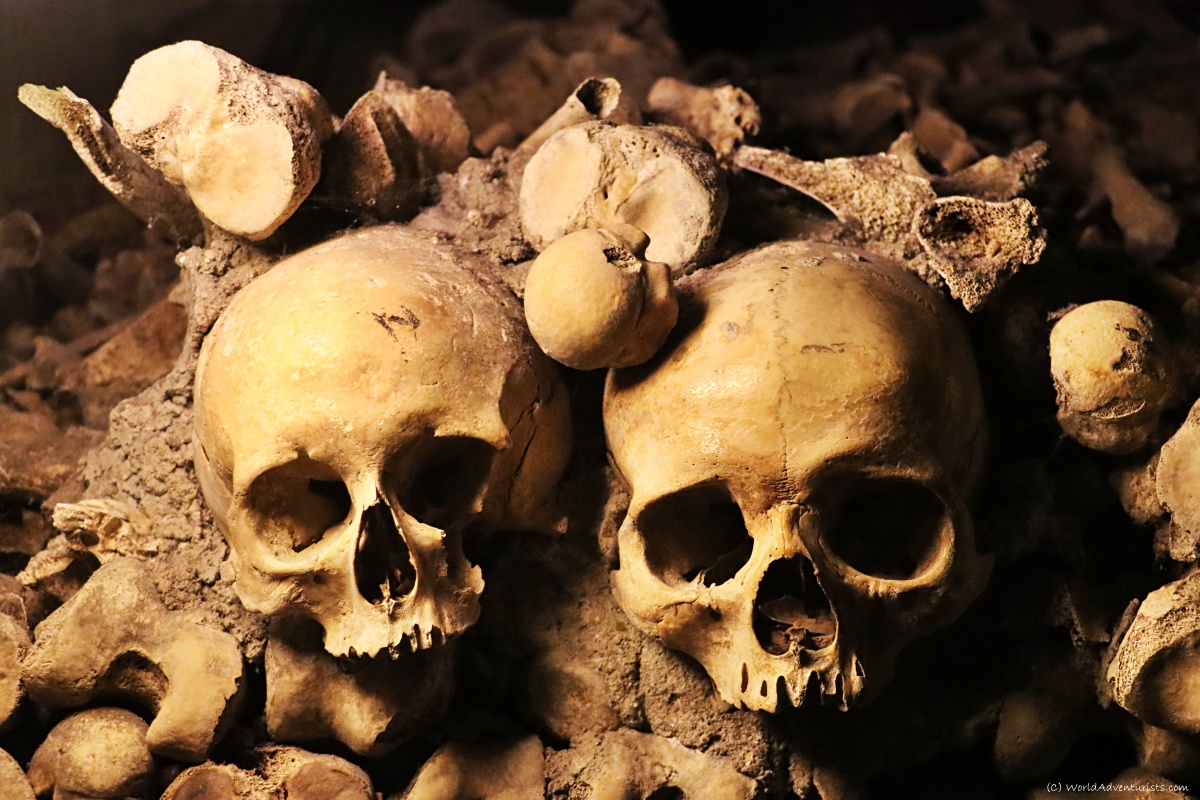

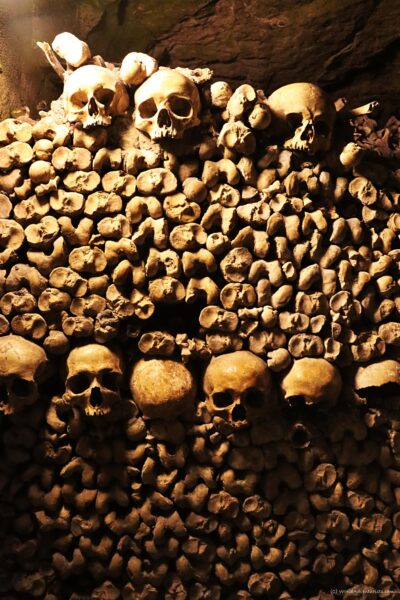


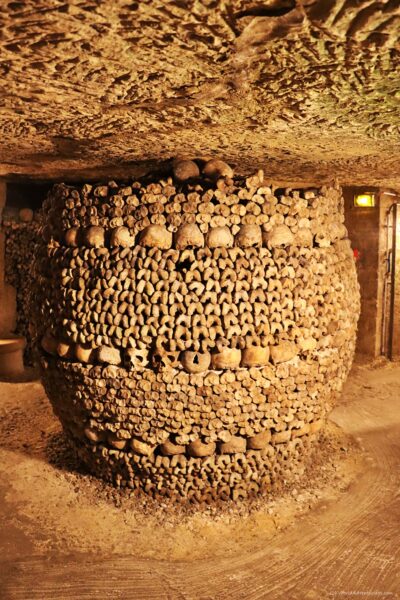







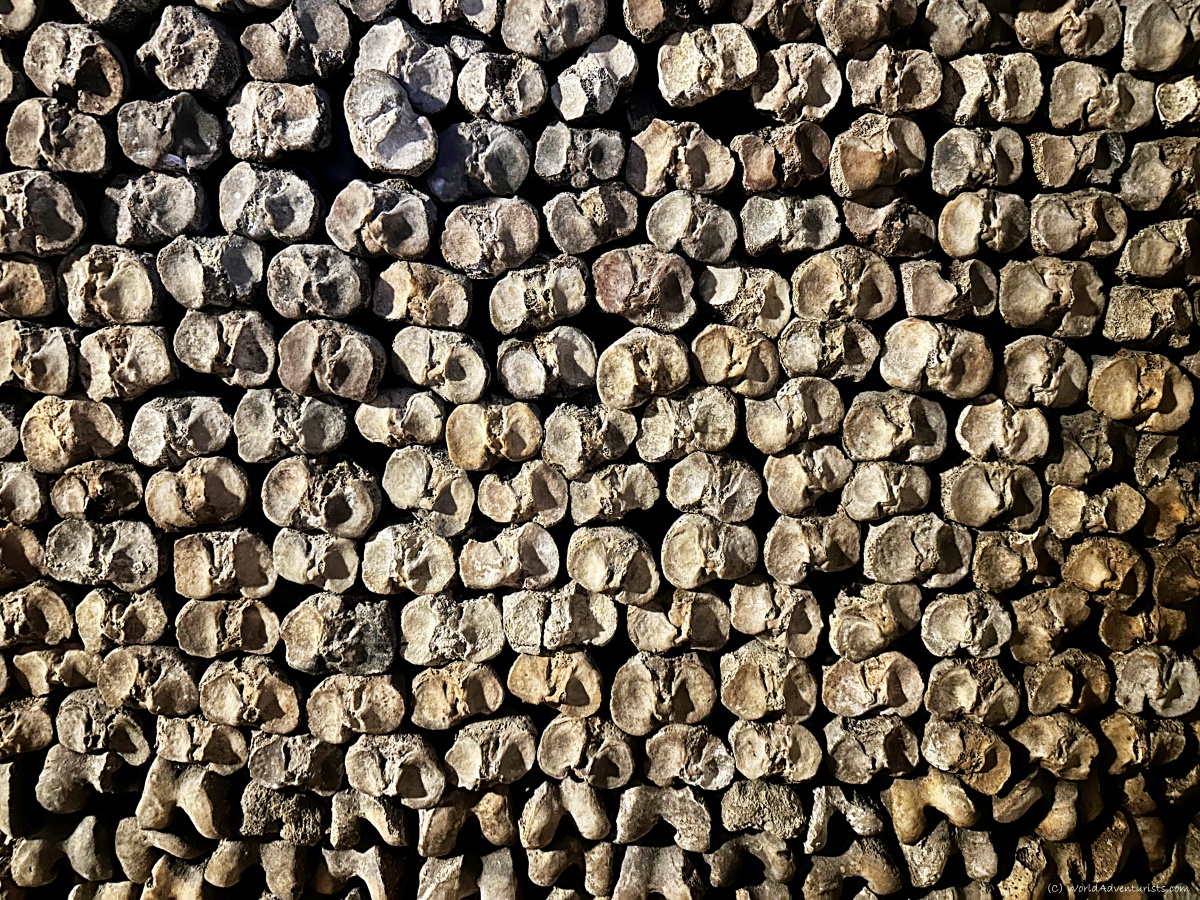








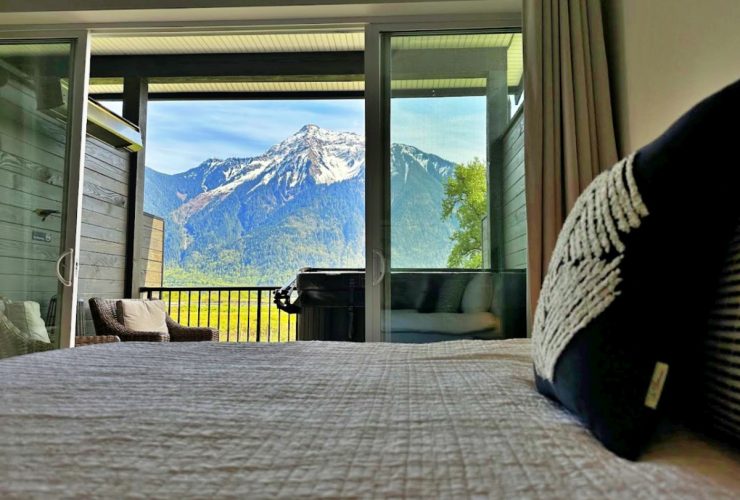

This is one ‘attraction’ I missed in Paris – will have to make sure to get there next time around. Looks like it would be creepy, but cool to see. Haunted? Maybe 😉